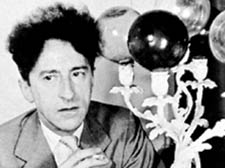| |

Jean Cocteau |
Bright idea, or coded message?
Changes to mural that featured in cult Da Vinci Code novel prompt new conspiracy theories
A CHURCH mural featured in the best-selling novel The Da Vinci Code has been mysteriously altered, fuelling speculation that a secret cult could be at work.
A band of gold paint has conspicuosly app-eared around the black sun in Jean Cocteau’s surreal depiction of the crucifixion at the Notre Dame de France church off Leicester Square.
In another twist, one of the angel’s eyes has also been painted another colour – posing the type of riddle that would not be out of place in Dan Brown’s novel, which has also been made into a Hollywood film.
And the phantom artist has left a calling card under the late master’s signature – the initials TA, are scribed beneath the French artist’s – prompting much chin-stroking from conspiracy theorists and cult enthusiasts.
Vicars at the church are flummoxed by the furtive act and theories abound. Some believe it could be a sign left by a member of the Priory of Sion – a mythical secret society the novel alleges Cocteau is grandmaster of, along with Leonardo Da Vinci and Victor Hugo. Another theory is that it could be an act of subversion from a member of the Catholic sect Opus Dei, who may be angered by the artist’s connection to the society, which the book claims guards the secrets of the Holy Grail.
Clive Prince, conspiracy theorist and co-author of The Templar Revelation – the book Dan Brown acknowledged as the inspiration for the Da Vinci Code – said the culprit was likely to be someone who knows the symbolic meaning of the painting.
He said: “It could be a prank from someone who knows the book, pretending to leave a clue about the existence of a secret society. Or it could be someone connected to the The Priory of Sion. The society is largely a hoax itself, but evidence suggests it is a front for other masonic societies who don’t want to be traced by researchers.
“Whoever did it clearly thinks they are adding another layer to what is a very symbolic piece of art and it has got my conspiracy radar on full alert. It is a fascinating occurrence, especially painting a band of light around the sun which has been a fierce topic of debate since it was painted.”
Mr Prince went on to say that Cocteau, who was most famous for his films and poetry, was a well-known occult figure when he painted the mural in 1960.
He said: “Cocteau and La Crucifixion figure prominently in the Templar Revelation and the Da Vinci Code.
“The painting itself does not sit very well with traditional Catholic understandings of the crucifixion. The blue rose at the bottom of the cross is a well-known occult symbol as is the black sun. There is no doubt that Cocteau dabbled in masonic and occult circles.”
Other oddities include a character, apparently Jesus, not on the cross but watching someone else’s feet bound to the cross. Cocteau, who died shortly after the work was completed in 1963, has also painted himself in the mural, bizarrely looking away while all the other characters face the cross.
Father Joaquin Fernandez from Notre Dame de France says he is completely stumped by the additions to the mural.
He said: “It is a complete mystery. It’s not like its a random act – it’s completely deliberate. Someone must have come in with a ladder and done it.
“People are saying that we did it because the mural was sacrilegious. That simply isn’t true. We are getting a restoration expert in from France to try and restore the work.”
The novel, which caused uproar from the Catholic church when it was published in 2003, claims that Mary Magdalene was pregnant with Jesus’s child when he died on the cross. According to the story, the Holy Grail is not a physical chalice, as commonly supposed, but Mary Magdalene herself, who carried the bloodline of Jesus. The story follows that the Catholic church and members of Opus Dei, suppressed the secret for 2,000 years in order to obscure the role of women in the origins of Christianity and because the truth would reveal Jesus to be mortal.
Jean Cocteau brought a huge following when he began work on the church in 1959.
He had to be protected from the army of reporters and fans by high wooden scaffolding. |
 |
|
| |
| |